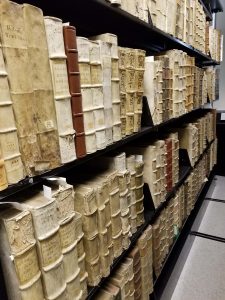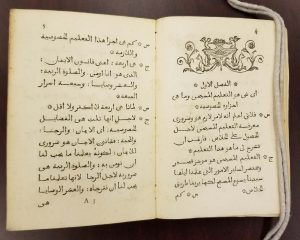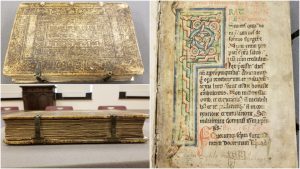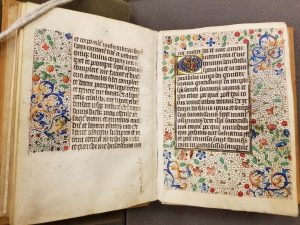
Think back to the last book you read. How old was it? Were the pages brittle or waxy, thick or thin? How did the cover and pages feel in your hands? Was there a smell to the book – freshly printed or a musty odor? Did the book catch the eye with its cover, type, or images? Did it make a sound when opened – a crisp snap of a never-before-opened spine or the dull groan of well-worn binding? Was picking up this book an experience of all the senses?
While we certainly do not taste our books, there is no way to avoid having an otherwise full sensory experience when entering Rare Books and Special Collections. Contained within its stacks are 70,000 volumes, spanning 10 centuries. The collection includes a wide range of materials from medieval legal texts and early modern musical pieces to twentieth century textbooks and first edition novels. The aroma and sights immediately catch one’s attention, and the feel and sound of each book as you open it offers a reminder of its age.
This past academic year, the Archives staff has been assisting in Rare Books. In addition to answering reference questions and exploring the materials contained within its stacks, we have hosted three classes in the space. Each class came from a distinct program and reviewed different materials with varying learning goals in mind. Much as we are whenever a class comes to handle archival documents for the first time, we were excited to provide the students with their potential first experience of accessing rare books.

In the fall, we hosted students from the School of Theology and Religious Studies as part of a “History and Theory of Catechetics” course. During their visit, the students were able to work with dozens of catechisms spanning several continents, numerous languages, and six centuries. Tapping into the collections of sixteenth-century folios and assorted Catholic theological and lay devotional publications, we were able to create an evolutionary display of catechisms from the fifteenth century to the present. Among the highlights were an Arabic catechism from 1770, a Navajo catechism from 1937, and a series of pocket catechisms from the nineteenth century. Supplementing this collection with materials from the Archives, we were able to bring the students from the Council of Trent to the United States Conference of Catholic Bishops.
As the new semester began in the cold of January, our staff prepared to host another visiting class, this time from the School of Philosophy. Entitled “Before Printing: The Establishment and Transmission of Ancient and Medieval Texts,” the course’s professor wished to expose her students to the physicality of the manuscripts they would study over the coming months. From our medieval manuscript and incunabula collections, we provided several Thomistic philosophical and theological treatises. Through a partnership with the Semitics/ICOR Library, the class was also able to review Arabic philosophical texts. While the students would primarily continue to work with facsimiles and digital copies of manuscripts this semester, having that initial opportunity for a full sensory experience is key to both contextualizing the sources and eliciting excitement.

My own first exposure to manuscripts was in Rare Books at Catholic University. Working with a medieval copy of Gratian’s Decretum as part of a class project helped me appreciate the beauty and wonder of these texts, and solidified my excitement for curation and historical research. I would never have guessed I would be helping provide access to these same materials years later!
Finally, our most recent academic visitors came as part of a Greek and Latin course, “Latin Paleography.” In addition to two codicology workshops held in Rare Books, the students will each work closely with a medieval manuscript in our collections to create a catalog entry. The manuscripts held by the University are thus providing valuable tools for the students to better understand the materiality and scribal norms of the medieval written word.
In addition to its strengths in Catholic history, Rare Books contains several unique collections, including a Malta collection, the Clementine Library, the Connolly Irish Collection, the Richard N. Foley Modern English Collection, its American Catholic Pamphlets and Parish Histories Collection, and much more.

Fundamentally, the collection’s value to the Catholic University community and broader scholarly world lies in its ability to provide students and scholars with opportunities to connect with the history of the written word as well as the contexts and ideas provided by each text. Plus, as the class visits illustrate, it is a wonderful source of collaboration for its sister special collections on campus!
For more information on Rare Books, see: https://libraries.catholic.edu/special-collections/rare-books/index.html
Questions may be addressed to: lib-rarebooks@cua.edu
